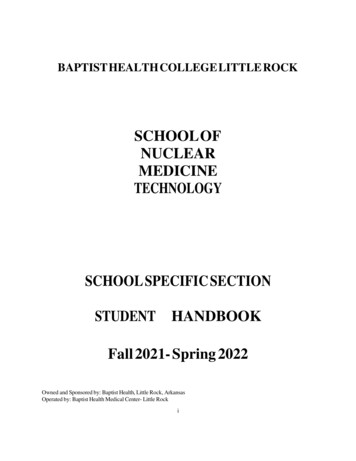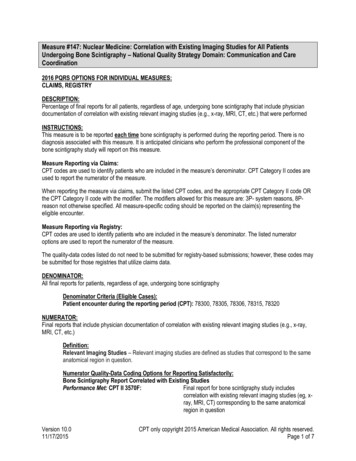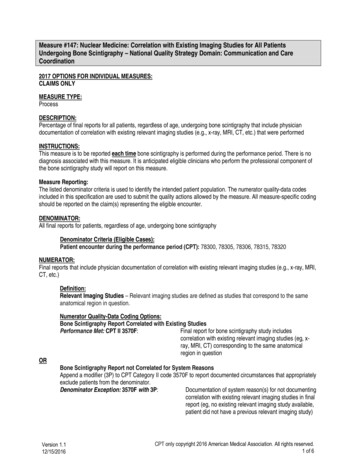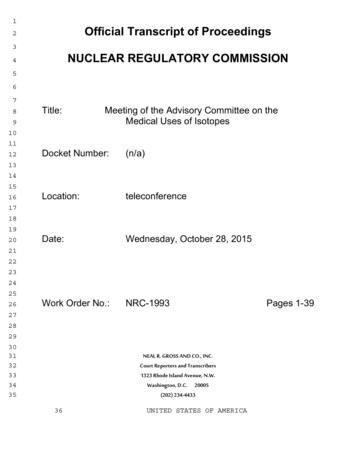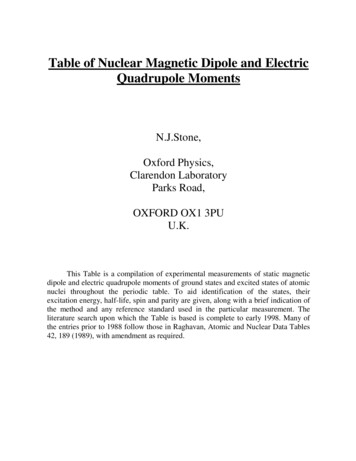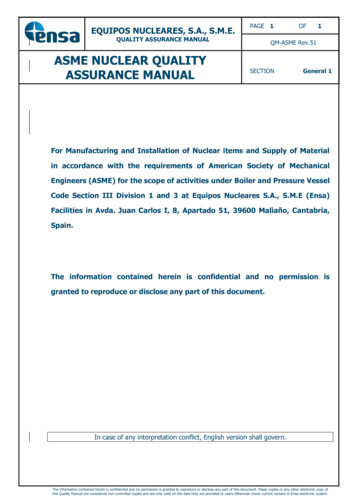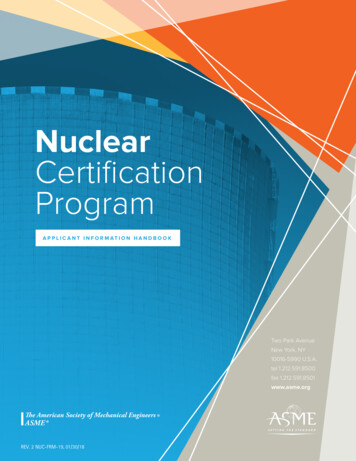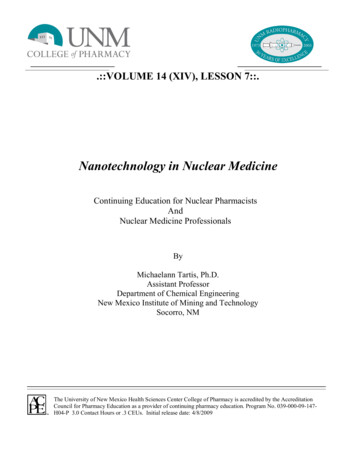
Transcription
.::VOLUME 14 (XIV), LESSON 7::.Nanotechnology in Nuclear MedicineContinuing Education for Nuclear PharmacistsAndNuclear Medicine ProfessionalsByMichaelann Tartis, Ph.D.Assistant ProfessorDepartment of Chemical EngineeringNew Mexico Institute of Mining and TechnologySocorro, NMThe University of New Mexico Health Sciences Center College of Pharmacy is accredited by the AccreditationCouncil for Pharmacy Education as a provider of continuing pharmacy education. Program No. 039-000-09-147H04-P 3.0 Contact Hours or .3 CEUs. Initial release date: 4/8/2009
-- Intentionally left blank --- Page 2 of 39 -
Instructions:Upon purchase of this Lesson, you will have gained access to the online site where this lesson and thecorresponding assessment are located. http://hsc.unm.edu/pharmacy/radiopharmacyCE/To receive a Statement of Credit you must:1. Review content2. Complete assessment, submit answers online and pass with a 70% (you will have 2 chances topass)3. Complete lesson evaluationOnce all requirements are met, a Statement of Credit will be available in your workspace. At any timeyou may "View the Certificate" and use the print command of your web browser to print thecompletion certificate for your records.NOTE: Please be aware that we cannot provide you with the correct answers to questions you gotwrong. This would violate the rules and regulations for accreditation by ACPE. We can however, tellyou which questions you did receive wrong. You may contact the CE Administrator to request thisinformation.Disclosure:The Author does not hold a vested interest in or affiliation with any corporate organization offeringfinancial support or grant monies for this continuing education activity, or any affiliation with anorganization whose philosophy could potentially bias the presentation.- Page 3 of 39 -
Nanotechnology in Nuclear MedicineByMichaelann Tartis, Ph.D.Editor, CENPJeffrey Norenberg, MS, PharmD, BCNP, FASHP, FAPhAUNM College of PharmacyEditorial BoardStephen Dragotakes, RPh, BCNP, FAPhAMichael Mosley, RPh, BCNPNeil Petry, RPh, MS, BCNP, FAPhAJames Ponto, MS, RPh, BCNP, FAPhATim Quinton, PharmD, MS, FAPhAS. Duann Vanderslice, RPh, BCNP, FAPhAJohn Yuen, PharmD, BCNPAdvisory BoardDave Abbott, RPh, BCNPDave Engstrom, PharmD, BCNPMark Gurgone, BS, RPhScott Knishka, RPh, BCNPVivian Loveless, PharmD, BCNP, FAPhALisa Marmon, RPh, BCNPBrigette Nelson, MS, PharmD, BCNPJanet Robertson, BS, RPh, BCNPSamuel Ernesto, RPh, MBABrantley Strickland, BCNPDirector, CENPKristina Wittstrom, MS, RPh, BCNP, FAPhAUNM College of PharmacyAdministrator, CE & Web PublisherChristina Muñoz, B.S.UNM College of PharmacyWhile the advice and information in this publication are believed to be true and accurate at the time of press, the author(s), editors, or thepublisher cannot accept any legal responsibility for any errors or omissions that may be made. The publisher makes no warranty,expressed or implied, with respect to the material contained herein.Copyright 2009University of New Mexico Health Sciences CenterPharmacy Continuing Education- Page 4 of 39 -
NANOTECHNOLOGY IN NUCLEAR MEDICINESTATEMENT OF LEARNING OBJECTIVES:The purpose of this lesson is to provide a review of the ways that nanotechnology is currentlyimplemented in medical applications and the role that nuclear medicine plays within thoseapplications. Further, a few examples are presented on radiolabeling various nanocarriers for PETimaging and the feedback it provides on the design of nanocarrier systems. In this case, nuclearimaging serves as an assessment tool for designing new therapies and contrast agent formulations forimaging.Upon successful completion of this lesson, the reader should be able to:1. Describe nanotechnology advances in medicine and its impact on applications for both therapyand diagnostic imaging.2. Understand the requirements for designing a nanoparticle to carry a radioisotope for therapy orimaging purposes.3. Describe the design requirements for an imaging strategy, including the appropriate label andimaging modality for the task.4. Understand the physiologic processes that may alter the biodistribution of various labeledprobes.5. Discuss the barriers that nanotechnology must overcome for cancer treatment and detection.6. Define the limitations of various image analysis techniques.-Page 5 of 39-
COURSE OUTLINEINTRODUCTION . 8CHALLENGES FOR NANOTECHNOLOGY: TARGETING THERAPY TO TUMORS . 8PARTICLES . 9LIPID-BASED NANOCARRIERS . 9LIPOSOMES . 11MICELLES . 12MICROBUBBLES . 12NANOCARRIERS FOR HYDROPHOBIC DRUGS . 13PASSIVE TARGETING . 13ACTIVE TARGETING . 14PH-SENSITIVE POLYMERS IN LIPID VEHICLES . 14PEPTIDE AND ANTIBODY TARGETING FOR LIPID VEHICLES . 14EXTRACORPOREAL TARGETING . 16MAGNETIC BASED APPROACHES . 16ULTRASOUND BASED APPROACHES . 17LASER BASED APPROACHES . 18NUCLEAR IMAGING TO DETECT AND ANALYZE PARTICLE TARGETING PERFORMANCE . 19DELIVERY OF GAMMA-IMAGING AGENTS BY LIPOSOMES . 21PET Tracking of Liposomes and Nanoparticles . 22DYNAMIC IMAGING: QUANTITATIVE IMAGE ANALYSIS . 23CONCLUSION . 25REFERENCES . 27ASSESSMENT QUESTIONS . 36-Page 6 of 39-
-- Intentionally left blank ---Page 7 of 39-
NANOTECHNOLOGY IN NUCLEAR MEDICINEMichaelann Tartis, Ph.D.Assistant ProfessorDepartment of Chemical EngineeringNew Mexico TechSocorro, NMINTRODUCTIONNanotechnology is loosely defined as systems that are less than 1 micron in diameter. Innanomedicine, these are organic and inorganic nanoparticles or nanocarriers that aid in non-invasiveimaging and therapy of various pathologies (1). The major application of nanotechnology in medicineis cancer therapy and detection, sometimes termed “theranostics” in which nanoparticles overcomebiological barriers to improve detection, diagnostics, treatment, and can even monitor diseaseprogression and therapeutic outcomes, in some cases using the same nanocarrier.The majority of this module reviews the challenges surrounding tumor detection and therapy and theways that nanotechnology and nuclear imaging are combined in the research realm to overcome thesebarriers. Goals in this area include creating novel particles and strategies for therapy, for nuclearimaging and diagnostics, and for nuclear imaging techniques that aid in the design of these novelparticles and delivery systems. The later portion focuses on a positron emission tomography imagingscheme that provides valuable feedback in the design of lipid based-particles for drug delivery.CHALLENGES FOR NANOTECHNOLOGY: TARGETING THERAPY TO TUMORSIn directing therapeutic molecules to tumors, it has been determined that three major limiting factorscontribute challenges that nanotechnology must overcome on a systematic scale. The first of thesefactors is an uneven distribution of a drug molecule in the organs of the body, where kidney and liverhave the most concentrated levels of drug because they are highly vascular organs. Secondly, smallmolecules are readily excreted, and therefore have a short circulation times. The third factor is druginactivation by irreversible binding to proteins, while larger particles are retained in the spleen (2).The tumor itself provides many hurdles. The largest challenge is presented by the spatial and temporalheterogeneity of tumor vasculature (3, 4); this includes vessel diameter, length, permeability, integrinexpression, density, and spatial distribution. Some of these attributes are tumor size dependent, such-Page 8 of 39-
as the necrotic cores of tumors that result from high interstitial pressure and lack adequate vasculature.While increased blood flow to tumors serves as a diagnostic marker in nuclear imaging (5), blood flowwithin a tumor is dependent on the vessel network, pressure, and blood viscosity and overall isdisorganized and lower than other tissues. Tumor vasculature is tortuous and unpredictable, and as aconsequence, it is hard to develop therapeutic strategies. A recent approach to improve therapeuticdelivery is priming the tumor tissue with a course of treatment that changes tumor properties, such asinterstitial pressure, to favor diffusion and convection to carry the therapeutic payload to its destination(3). While this notion seems counter-intuitive, a pretreatment of anti-angiogenic therapy or nutrientgradient based therapy was designed to improve or normalize blood flow and hence convectivetransport of a drug into a tumor. This technique has been used with some success, which is attributedto a pruning effect where inefficient and immature blood vessels are shut down leaving behind therelatively mature vessels to flourish and become more efficient in transporting molecules into thetumor (6-8).Mathematical models (3, 9) provide relationships between various tumor parameters and therapeuticdelivery to solid tumors. Among the modeled attributes of tumors that contribute to the challenges indelivery are limited diffusion and convection. Tumor size also plays a role in the outcome of varioustreatments (10). It is more difficult to treat large tumors due to the increased interstitial pressure andlack of vasculature in the necrotic core. The increased interstitial fluid pressure resulting from poorlymphatic clearance hinders extravasation, as well as hindering further transport into the interstitium.In some cases, this can also be an advantage, as tumors retain macromolecules since lymphaticclearance of interstitial fluid is missing (2). To conclude upon the many challenges in deliveringmolecules and particles to tumors, the dynamic nature of tumors greatly affect the effectiveness oftherapy and should be assessed when designing schedules for treatment.PARTICLESLipid-Based NanocarriersThe so-called pharmaceutical “magic bullet” is a vehicle capable of delivering, yet, limiting treatmentof a therapeutic molecule to a specific target (11). There is a plethora of diverse and importantparameters in developing a drug delivery system with this ability, whether the vehicle is a liposome,micelle, microsphere or polymeric drug complex. A few of these factors are stability, size, charge,solubility, composition and drug-to-carrier ratio (12). If the drug to carrier ratio is low, potency of thedrug to be delivered must be high to avoid carrier toxicity. In general, the pharmacokinetic profile of a-Page 9 of 39-
drug-carrier complex is between that of the free drug and the carrier profile. If the drug is releasedslowly, the overall profile is close to that of the carrier, while approaching that of the free drug whenthe drug is released rapidly (13). Lipid based complexes composed of high-phase-transition lipids,cholesterols, and glycolipids create a slightly negative surface charge, protecting against opsonizationand aiding in increasing circulation time (10, 14-18). Figure 1 provides illustrations of various lipidbased particles. Positively-charged vehicles tend to be cleared rapidly by the lungs, spleen, and livermaking them attractive for delivery in those organs (19) and unattractive for tumor targeting. Sizeplays a significant role in biodistribution; larger sized particles are restricted to the vascularcompartment, which increases the half-life and the area under the concentration-versus-time curve,decreases clearance of the drug, and decreases volume of distribution (10, 12, 20). However, thespleen filters out particulate drug delivery systems that are larger than 200 nm in diameter. This is nota strict rule, as a vehicle’s ability to deform will aid in transport through this filter (21).Figure 1. Illustration of various lipid based particles. The microbubble, liposome, and micelle are not drawn toscale. In the case of the micrcobubble, a model drug or genetic material may be associated with the lipid shell.-Page 10 of 39-
LiposomesLiposomes are used as drug carriers because they are composed of biologically inert materials and aretherefore non-toxic. Similar to cell membranes, they are vesicles made of self-assembled lipidbilayers. They have the ability to carry and protect a drug of interest from the external environment.Practically any drug can be incorporated into a liposome. Hydrophilic drugs are carried in the aqueousinterior of a liposome, while hydrophobic and amphipathic molecules associate with the fatty acylchains of the bilayer (11). The volume of aqueous media encapsulated in liposomes is much largerthan that of the hydrophobic environment, making hydrophilic drug payload inherently larger;however, drug potency also affects the overall efficacy of therapy. Hydrophobic drugs with lowsolubility in blood are more susceptible to release from the vehicle to cell membranes, plasma, andproteins (12, 22). Delivery by liposomes also eliminates the need for using the highly toxicsolubilizing agents often needed for delivering hydrophobic materials (23).Currently, there are many successful methods for drug entrapment in liposomes. Some of thesemethods are extrusion, sonication, detergent dialysis and reverse-phase evaporation (11). Theextrusion process using polycarbonate filters of various pore sizes allows control of the upper size limitof liposomes, which is useful when designing particles for long circulation and targeted applications.Liposomes can be endocytosed or fused to cells yielding the ability to effectively deliver drugs acrossthe cell membrane. To achieve maximum localized delivery, the liposome must have high efficiencyfor entrapment of the drug into the liposome, prevent uptake by the reticuloendothelial system (RES),and have affinity for the target. One way to prevent RES clearance and increase the circulation time isthrough coating the liposomes with a variety of materials (10, 11).Polyethylene glycol (PEG) coating of the liposome was the breakthrough leading to second-generationliposomes. PEG increases the hydrophilicity of the liposomes by concentrating hydrating groups onthe surface, making it more in soluble aqueous fluids. This sterically hinders electrostatic andhydrophobic interactions with blood components, thereby reducing protein binding and opsonization(10, 24, 25). Numerous other surface modifications and liposome coatings have been examined toprovide a hydrophilic sheath that would protect hydrophobic moieties of drug delivery vehicles fromprotein and enzymatic interactions, including biocompatible polymers such as, poly(ethylene oxide)(PEO), poly(propylene oxide) (PPO), polyesters, and their derivatives (26). Long circulation timesintroduce the issue of drug release from the liposome. High diffusion rates across the liposome bilayerare a concern; however, the drug must diffuse before the liposome clears the target tissue (2).-Page 11 of 39-
MicellesMicelles are self-assembling structures composed of lipids or polymers, somewhat similar toliposomes, however, they are spherical aggregates and not lipid bilayers. The typical size range formicelles is on the order of tens of nanometers in diameter. In an aqueous environment, thehydrophobic moieties mingle in the core of the structure and polar head groups are in contact with theaqueous environment. This structure can accommodate hydrophobic and amphipathic molecules (12,21, 27, 28). Examples of micelles used in conjunction with active or extracorporeal targeting arediscussed in more detail in following sections.MicrobubblesAs the name signifies, microbubble contrast agents are on a different size scale, where lipid-basedmicrobubbles can range from sub-micron to tens of microns. It is size that limits their biodistributionto the blood pool while intact. Microbubbles act as ultrasound contrast agents, increasing the acousticsignal reflected from blood. The increased signal arises because they are gas filled, making themlower in density and highly compressible compared with surrounding blood. Microbubbles oscillatespherically and nonlinearly when exposed to acoustic pressure waves because of these properties,making imaging and detection a highly sensitive modality. Microbubbles have been successful withgene delivery, but have had limited success with drug delivery due to the lack of space and adequateenvironment to carry large amounts of drug. Gene delivery with microbubbles has been successful dueto the fact that plasmids and other genetic vectors can be associated with the microbubble (29) andconsequently combined with cavitation induced by ultrasound application.In vivo delivery of genes using microbubbles as a carrier has been demonstrated with and withoutultrasound. Antisense phosphorodiamidate morpholino (PMO) has been delivered to endothelial cellsin vivo using albumin-coated microbubbles, which bind to sites of vascular injury (30). Successfulgene delivery to the myocardium with ultrasound-targeted microbubble destruction has also beendemonstrated, where microbubbles had hVEGF plasmid-containing liposomes attached to thephospholipid shell (31).Microbubble hybrid vehicles, called lipospheres (12, 32-35), have both targeting ligands and a thickdrug-carrying oil layer and can be combined with ultrasound radiation force pulses to
Continuing Education for Nuclear Pharmacists . And . Nuclear Medicine Professionals . By . Michaelann Tartis, Ph.D. Assistant Professor . Department of Chemical Engineering . New Mexico Institute of Mining and Technology . Socorro, NM . The University of New Mexico Health Sciences Center College of

